Gathering Information from Graphs
|
Student: I have seen people talking for hours about the same graph, as if they were reading a book. How is it possible for one little picture to have so much information in it? Mentor: Do you know this saying: "A picture is worth a thousand words?" A mathematician would say that a graph is worth thousands of words. Of course, it is only possible because in mathematics there are many conventions about what each symbol or part of the graph means. This is not very different from the rest of life: for example, when you see a picture of a book or read the word "book," you do not need a long description of what it is and what it does. If you see bright cartoonish characters on the cover of a book, you may assume that it is a book for children, and so on. It may be easier to read symbols in math and sciences than in the rest of life. Do you know why? Student: Because there are exact agreements on what each symbol means. Let us try to read a graph for practice. Mentor: Would you like to draw a graph? Student draws:
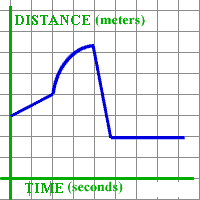
Mentor: Some parts of your graph are very easy to read. Student: Like the last part, when the distance was not changing at all. I can tell a little story about it. Let me choose units for time and distance, say, seconds and meters. So my story about the last part would be: "For about three seconds, everything was still. The person stayed two meters away from the origin." Mentor: When "everything is still," in mathematical terms, the dependent variable (distance in your example) does not change when the independent variable (time in your example) changes. In math, things that do not change are called constants. Functions that stay the same no matter what the variable does are called constant functions. So the last part of your graph is an example of a constant function graph. Student: I think all straight line parts should be easy to read. In the first part of the graph, the person moved from a point three meters from the origin to the point four meters from the origin. It took two seconds. It took one second to cover the first half-meter, and one more second to cover the second half-meter. Mentor: With this type of motion, called uniform, it always takes the same time to cover the same distance. In other words, velocity does not change. Student: We can say that for uniform motion velocity is constant. So, if I see a straight line graph of distance vs. time, I will know that the velocity was the same. Mentor: It is possible to find velocity for uniform motion from the graph of distance vs. time. Try to do it with the parts of your graph that describe such motion. Student 1: That would be the first part and the third part. Student 2: And the last part. For the last part, velocity is zero. Student 1: Right. For the first part, the velocity is 1/2 meter per second. Student 2: And for the third part of the graph, it is about 4 meters per second. Mentor: I would put the minus sign in front of 4 for the third part, because the person we describe was moving backwards, and getting closer to the zero point. Student 1: So for the third part of the graph, velocity is -4. Student 2: Here are more examples of uniform motion. I used v for velocity.
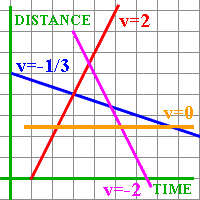
Student: The second part of the original graph is not a straight line:
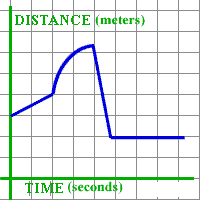
Mentor: This means that velocity was changing during that time. The question is, was the person speeding up or slowing down? Student 1: During the first second, the person covered about two meters, and during the next second, about a third of a meter. Student 2: If you look at half seconds, you see the same: a meter and a half during the first half-second, a half of a meter during the second half-second, and a third of a meter during the third half-second. The person was slowing down. Mentor: Can you draw more graphs of distance vs. time when velocity decreases? Make sure to include a couple of graphs with negative velocity. Student 1 draws:
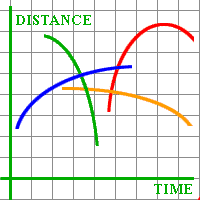
Student 2: I do not understand why velocity decreases in your graphs. Take the green graph: it shows that the person covered about half a meter in the first second, about a meter in the second one, and about two meters in the third second. How is it "less and less"? Student 1: You are forgetting the sign! The person described by the green graph is moving faster, but velocity is negative (the person is going "back"), so it is really decreasing. You can say it becomes "more negative." Mentor: The graphs that describe functions with the rate of change (velocity) decreasing are called concave down. Do you see why? Student 1: They are curved down. Student 2: I guess if a graph is concave up, velocity will increase and the graph will look like this:
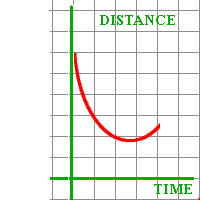
Student 1: You are right. I will make the table for distance and velocity approximations for this one:
Student 2: Your table helps to see more exactly how velocity increases. The amazing thing is that all this information was already in the graph. Mentor: Now you can see why and how people can talk about a graph for hours! |
